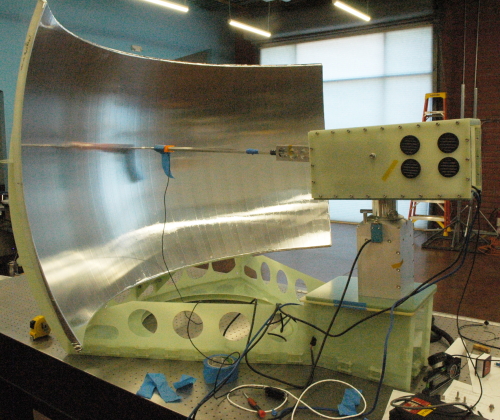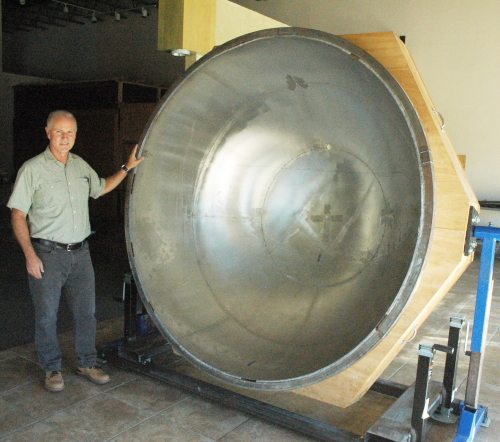Freefall: an antenna company for space

Last week I had the opportunity to tour the offices space-based antenna startup Freefall, another one of Tucson’s many space-related companies.
Not surprisingly (and probably to the company’s credit), the offices and facility were themselves not that impressive. Essentially it was an open space with some areas reserved for desks and workers, and other areas where engineers could do some antenna construction and testing. In one corner was what the company’s CEO, Doug Stetson, labeled “their antenna graveyard,” past antenna experiments that were no longer needed or in use.
However, like all of these new independently-owned small aerospace companies popping up worldwide now that western governments have given up control of their space programs, what makes this company stand out is the creative innovations — both in design and manufacturing — that it brings to its products. In the case of Freefall, those products are all kinds of antennas, designed for all kinds of space-related uses.
First, there is design. The key to Freefall’s business model is its spherical dish antenna design.

One of the big parabolic antennas used in
NASA’s Deep Space Network
Traditionally, antennas for spacecraft have used parabolic-shaped dishes, which provide very efficient data transmission. The precise shape of a parabolic dish — with one central focal point — requires that it be pointed very precisely, both to transmit as well as receive. In the past this precision did not pose a serious problem because the target of most satellites was relatively fixed. For example, in looking up at a geosynchronous satellite you basically will always look at the same spot. No need to move. Similarly, a geosynchronous satellite itself not need to adjust its antenna much, as it will usually be looking down at the same ground station, always at the same spot.
The case is somewhat the same in deep space communications, such as the picture to the right of one of the big parabolic dish antennas NASA uses to communication with planetary probes from Mars to beyond Pluto. The large distances between the probe and the Earth generally reduces the amount the dish needs to move to maintain contact.
That paradigm however is ending. Communication satellites are now shifting to low Earth orbit constellations of many moving satellites, all of which will require their antenna dishes to move continuously to hit their targets. And those targets will be at many different locations, moving quickly across the sky. While it is possible to make this work with parabolic dishes, doing so raises the costs significantly because of the need for many moving parts to allow the dish to move and point. And the more you move the more complex and expensive and heavy those moving parts become.
Freefall has instead proposed a different idea. Why not use spherical dishes instead? A spherical dish will not be as efficient in transmitting data, but there will be no need to point the dish at all. Any spot on the dish can be its focal point. You simply have to move your pick up feed above the dish to capture the reflection. “That’s really the feature that makes this unique,” Stetson explained.
Think of how the Ariceibo radio telescope worked. The dish was a non-moving bowl on the ground. Only the pick-up antenna receiver above it moved to find the right focal point on the dish. Freefall’s spherical antennas essentially do the same.
In addition, by being spherical the dish can simply be a balloon that you inflate. Such a design can be small enough and light enough to easily fit inside a cubesat. Because cubesats are so small, with each unit about 4 inches square, their ability to download much data has always been limited. There has been no way to fit them with a large enough high gain parabolic antenna. The before and after graphics below show how Freefall’s concept of inflatable spherical high gain antenna would solve this problem.

On the left the spherical balloon dish has begun to inflate. On the right it is deployed, and transmitting or receiving. The whole antenna at launch would fit inside one and half cubesat units (about 4″ by 4″ by 6″), but when deployed the antenna would be far larger.
Nor is this merely a concept. The company has tested it repeatedly on the ground, as well as on a high altitude stratospheric balloon. Come January it will take this testing into orbit, when it will fly its first in-space demo mission of this inflatable spherical antenna, launching as a payload on Firefly’s next Alpha launch. Called Catsat, the satellite will test the deployment of the antenna dish and its ability to transmit a great deal of data from a cubesat quickly.
During the CatSat mission, the FreeFall inflatable antenna will transmit high-definition Earth imagery to a 6.1 m ground station antenna located at [University of Arizona’s Tech Park in] Tucson. A second whip antenna will also be used to probe how the ionosphere structure varies at different times of the day.
The cubesat was assembled and tested by students at the University of Arizona, and has a planned mission of six months.

Freefall is also designing spherical dish antennas for ground stations. The photo to the right is an antenna Freefall is about to ship for testing, and is being built for a customer with an already orbiting communications satellite constellation. Though the dish is not a full half sphere, its shape is still spherical, with the feed above it designed to move rather than the dish itself.
These spherical dishes illustrate the type of design innovation a small independently owned company like Freefall brings to the table. The story behind the construction of this particular prototype ground station illustrates the manufacturing innovation that comes from a small independently owned company.
When Freefall first put out a request for bids to make the dish, the bids from a number of metal manufacturing firms exceeded $100K, with one offer as high as $180K. More worrisome was that delivery could take as long as 32 weeks. Freefall could not afford those prices or long delivery time.

“Our mechanical engineering consultant, Bob LeCompte, contacted his friend Nick Burke who is a local sculptor,” Stetson explained. “Together they came up with a plan to use an old reflector dish we had at FreeFall as a mold. Nick took a casting from this mold back to his shop and used it to create a smooth fiberglass reflector of the proper shape. He was able to create this in about a month for less than 20% of the cost quoted by the metal manufacturing firms.”
That old reflector dish can be seen to the right, with CEO Stetson standing beside it. Its origins however are not what you would expect. “It was originally made to be a lawn ornament for rich Chinese homeowners,” Stetson noted. “Having large metal spheres is a very popular decoration in yards in China.” Freefall bought it, had it cut in half and shipped to the U.S. where engineers used it for antenna tests.
Since it is spherical, any part of it will match the curve needed, since the ground station dish was only part of a sphere. “You can still see his drawn mold lines,” Stetson added. “That gave us a way to get a spherical shape very cheaply.” This clever trick alone saved an enormous amount of time and money.
The older big companies that used to dominate the aerospace industry would never have permitted such tricks. The excuses will all sound familiar: “Too risky! It doesn’t follow our standard procedures! What if it doesn’t work?!” Moreover, as they generally worked on cost-plus contracts, saving money or time went against company policy. Taking longer and costing more were both features, not bugs.
Freefall instead needed to get the job done on time and at an affordable price, and went ahead anyway. The result is a success that will not only benefit Freefall, but its customers.
As more freedom and competition is brought back into the aerospace industry, such things will become more and more common. For the new companies like Freefall, it will be par for the course. For the older, traditional big space companies, the challenge will be to change, or die. Some of these larger companies, such as Lockheed Martin, seem to be seeking out ways to make this change. Others, like Boeing, seem mired in the old ways of doing business, and thus might simply not survive this new competition.
Regardless, the future indeed does look bright for the exploration of space. Freedom and capitalism is finally being allowed to make it affordable.
And for Freefall, the big test for its future will take place early next year, when CatSat reaches orbit and the company’s engineers order it to deploy the antenna. If that antenna works as promised, the company will then be poised to become a major player in the future of space communications.
On Christmas Eve 1968 three Americans became the first humans to visit another world. What they did to celebrate was unexpected and profound, and will be remembered throughout all human history. Genesis: the Story of Apollo 8, Robert Zimmerman's classic history of humanity's first journey to another world, tells that story, and it is now available as both an ebook and an audiobook, both with a foreword by Valerie Anders and a new introduction by Robert Zimmerman.
The print edition can be purchased at Amazon or from any other book seller. If you want an autographed copy the price is $60 for the hardback and $45 for the paperback, plus $8 shipping for each. Go here for purchasing details. The ebook is available everywhere for $5.99 (before discount) at amazon, or direct from my ebook publisher, ebookit. If you buy it from ebookit you don't support the big tech companies and the author gets a bigger cut much sooner.
The audiobook is also available at all these vendors, and is also free with a 30-day trial membership to Audible.
"Not simply about one mission, [Genesis] is also the history of America's quest for the moon... Zimmerman has done a masterful job of tying disparate events together into a solid account of one of America's greatest human triumphs."--San Antonio Express-News


I wonder just how small they can make these? PocketQube satellites could use something like this but they are based on 50mm cubes.
Great article.
Love it !
So much for my CB Whip antenna.
Creating outside of a box ?
What box ?
Love it !
Joe: It is probably premature to expect this for a PocketQube. The January demo flight is the first in-space test of the cubesat design, 1.5U. Should that succeed, however, they will likely go into production and eventually consider larger and smaller designs.
I have though about dual use tethers for such purposes…and perhaps a novel space elevator. Imagine not one-but two statites, with cables crossing each other in an X shape. By simply having the two solar sails tack towards or away from each other- the intersection can be raised or lowered. Scissor-lift to the stars? Adjustable antenna?
Bob,
How do you maintain such a quality site producing such stellar information.
May the force be with you.
I know its probably not important for the larger inflatable dishes but what would temperature changes do to it?
Could they be compensated for or can the ball be inflated enough to make it irrelevant?
And if it can be inflated enough I wonder if an inflatable telescope would be possible? Just the tube body that holds the secondary mirror. The cube sat would hold the primary mirror and the camera equipment..
Excellent space journalism.